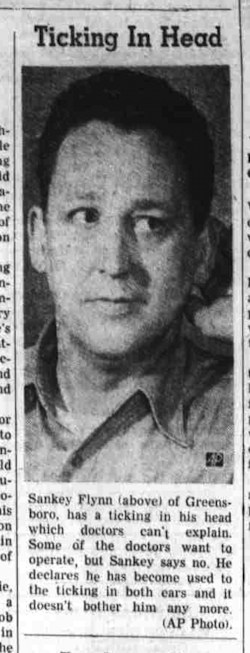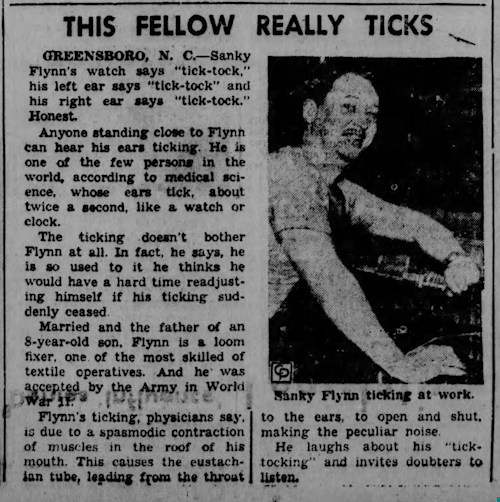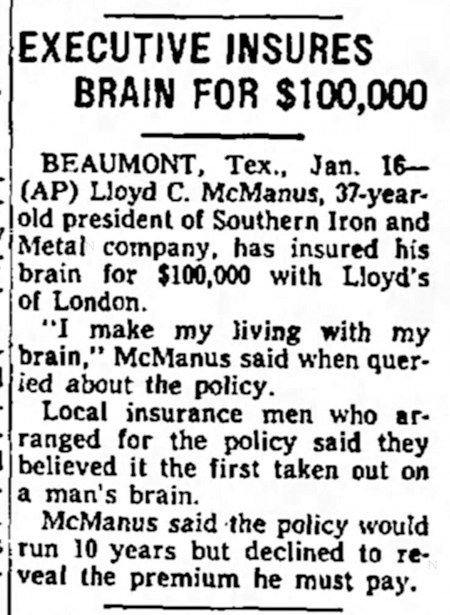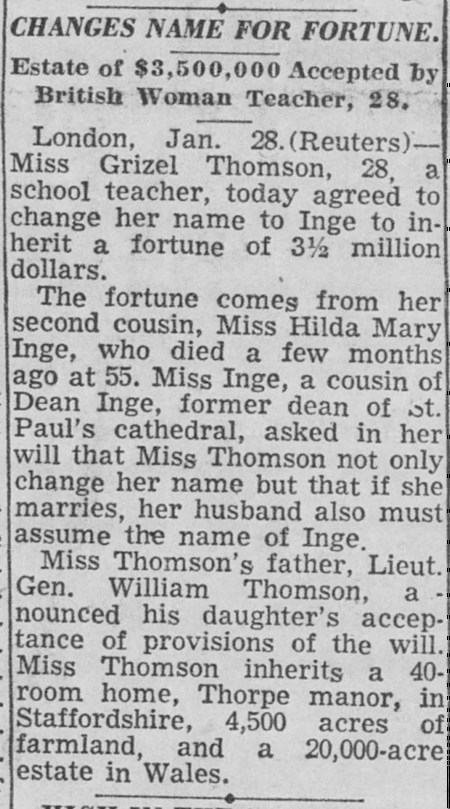1950s
The Tick Tock Man
Sankey Flynn (1918-2001) had an unusual condition. His ears made a ticking sound, about twice every second, which earned him the nickname "Tick Tock." The noise was so loud that other people could easily hear it. It was caused by a "spasmodic contraction of muscles in the roof of his mouth." He never tried to find a cure for his condition because he said he was used to it.I wonder how the TSA would have reacted to him.

The Waynesville Mountaineer - June 1, 1950

Somerset Daily American - Feb 26, 1951
Posted By: Alex - Sun Jan 10, 2016 -
Comments (0)
Category: Body, Human Marvels, 1950s
Fire Alibi
This has to be one of the worst excuses ever.
The Pantagraph (Bloomington, Illinois) — Mar 2, 1955
Posted By: Alex - Sun Jan 03, 2016 -
Comments (8)
Category: Accidents, 1950s
Insured his brain
1957: Lloyd McManus, president of the Southern Iron and Metal company, insured his brain for $100,000, noting that, "I make my living with my brain."The inevitable jokes followed in the media: A penny for his thoughts, what happens if he has a brainstorm, etc...

The Bridgeport Telegram — Jan 17, 1957
Posted By: Alex - Wed Dec 30, 2015 -
Comments (7)
Category: Insurance, 1950s, Brain
Perverts’ Mecca

Posted By: Paul - Wed Dec 30, 2015 -
Comments (8)
Category: Regionalism, Sexuality, 1950s
The Incredible Shrinking Radio
Despite the technological trend being obvious in 1954, I don't think anyone--SF writers or scientists or futurists--really anticipated something like an iPod.
Posted By: Paul - Tue Dec 29, 2015 -
Comments (6)
Category: Radio, Technology, 1950s
Changed name for fortune
1954: Grizel Thomson changed her last name to Inge, and as a result inherited $3,500,000. In 2015 money, according to the inflation calculator, that would be about $30 million. Not bad for a name change.I can't find any recent info about the Inge fortune, and whether possession of that last name is still required to get the money.

Kansas City Times - Jan 29, 1954
Posted By: Alex - Mon Dec 28, 2015 -
Comments (7)
Category: Death, Money, 1950s
Mechanical duck attacks puppy
Merry Weird Christmas, everyone!
The San Mateo Times — Dec 26, 1951
CHICAGO, Dec. 26 — A mechanical duck disrupted the Christmas day quiet in the Lonnie Miller home.
The toy, wound up by 8-year-old Donald Miller, waddled across the floor and latched on to the tail of Smokie, a 10-month-old puppy.
Smokie howled. So did Donald. The duck held on grimly to the tail which was entangled in its clockwork mechanism.
Donald's father took Smokie and the duck to the animal welfare league where Allen Glisch separated the two with pliers, a screwdriver and wire snippers.
Posted By: Alex - Fri Dec 25, 2015 -
Comments (5)
Category: Animals, Holidays, 1950s
Elmer Saves Christmas

Elmer research here and here.
Full story here.
Posted By: Paul - Sat Dec 19, 2015 -
Comments (3)
Category: Animals, Anthropomorphism, Fey, Twee, Whimsical, Naive and Sadsack, Holidays, 1950s
Advertising Spokesmen Least Likely to be Viewed as Kid-Friendly

[Click to enlarge]
Original ad here (on page 9).
Posted By: Paul - Thu Dec 17, 2015 -
Comments (4)
Category: Corporate Mascots, Icons and Spokesbeings, Comics, 1950s
Christmas Tune Co-opted
Curse you, Halo Shampoo, for tricking me into thinking I was going to hear a nice rendition of "Jingle Bells."
Also, smart move you made, covering up the majority of the hair in your hair-centric commercial with hats.
Posted By: Paul - Wed Dec 16, 2015 -
Comments (10)
Category: Holidays, Advertising, 1950s, Hair and Hairstyling

| Who We Are |
|---|
| Alex Boese Alex is the creator and curator of the Museum of Hoaxes. He's also the author of various weird, non-fiction, science-themed books such as Elephants on Acid and Psychedelic Apes. Paul Di Filippo Paul has been paid to put weird ideas into fictional form for over thirty years, in his career as a noted science fiction writer. He has recently begun blogging on many curious topics with three fellow writers at The Inferior 4+1. Contact Us |




